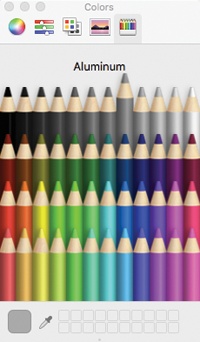Everywhere you look in OS X, you’ll find visual effects that would make any other operating system think about early retirement.
For example: Menus are transparent. You can set Excel 3D graphs to be slightly transparent so they don’t block other bars in a 3D graph. When you paste files into windows in icon view, their icons fade into view. When you open an especially long message in Mail, its text fades in from white. When you use Launchpad, it fades in and out. And when you switch accounts using fast user switching, your work environment slides off the screen as though it’s pasted on the side of an animated cube.
All these visual goodies owe their existence to Quartz (or its enhanced successor, Quartz Extreme, which is not available on older Macs).
OS X understands dozens of Mac and Windows graphics file formats. Better yet, its Preview program can open such graphics and export them in a different format, making it an excellent file-conversion program. You can confidently double-click graphics files—from a digital camera, scanner, or web download, for example—in any of these formats:
PICT files. For almost 20 years, the PICT file was the graphics format Mac fans were most familiar with. It was the graphics format used by the Mac Clipboard, and it was the format created by the Shift-⌘-3 keystroke (see Screen-Capture Keystrokes). Unfortunately, no other kinds of computers could open these files. The Preview program can no longer save graphics in the PICT format. It can open them, but only when it’s running in 32-bit mode.
TIFF files. The TIFF file format is a high-density, high-quality, uncompressed bitmap—that is, the Mac has memorized the color of each tiny dot in the file. Trying to enlarge one is like enlarging a fax: Make it too big, and the image breaks down into visible dots.
Nonetheless, TIFF files are very popular in the printing industry—the graphics in this book, for example, were stored as TIFF files. They print beautifully, work nicely in page-layout programs, and are understood by both Macs and Windows PCs. (They’re also pretty big files.)
JPEG files. This format is one of the most popular on the web, particularly for photos or other high-quality, full-color artwork. What makes JPEG files ideal for online use is that they’ve been compressed (using a program like Photoshop). Just enough of the color data has been thrown out from the original file to make the image a quick download without noticeably affecting its quality.
GIF files. GIF stands for graphics interchange format. Today, GIF files are used almost exclusively on the web, usually for solid-colored graphics like cartoons, headlines, and logos. (A GIF file can have a maximum of 256 colors, which is not even close to the photorealism of, say, JPEG. That’s what makes the GIF format inappropriate for photographs.)
PNG files. As it turns out, one of the algorithms used by GIF files is, technically speaking, the property of a company called Unisys, which threatened to sue everybody who was creating GIF files. “No problem,” said the World Wide Web Consortium. “We’ll just come up with our own replacement—a file format that has no legal strings attached.” What they created was PNG (Portable Network Graphics). You can save Photoshop and Preview documents in PNG format, and every modern web browser understands it. Screenshots you take in OS X are in PNG, too.
PNG files don’t lose quality when compressed, as JPEG files do. On the other hand, PNG files don’t accommodate animation, as GIF files do. And when it comes to photos, they don’t offer as impressive a size/quality balance as JPEG.
Photoshop files. If you’re a graphic designer or webmeister, this one is kind of neat: OS X can open (and Preview can even export) actual Photoshop files (except for so-called 16-bit RGB files). In practical terms, the fact that OS X can open and display these files means that you could use a Photoshop masterpiece, complete with layers and transparency, as, for example, an OS X desktop background.
BMP files. You can think of this graphics format as the PICT of the Windows world. It’s nice that OS X can open (and Preview can export) them, especially because you may occasionally find .bmp files on the web or attached to email messages.
Silicon Graphics, MacPaint, Targ. You could go your whole life without ever seeing a graphic in one of these formats. Silicon Graphics is, unsurprisingly, the format created by Silicon Graphics computers. MacPaint is a black-and-white, 8x10–inch maximum, ancient Macintosh graphics format that disappeared from the scene in about 1988. And Targ (Targa) is the format once used by products from Truevision.
Get Switching to the Mac: The Missing Manual, El Capitan Edition now with the O’Reilly learning platform.
O’Reilly members experience books, live events, courses curated by job role, and more from O’Reilly and nearly 200 top publishers.


